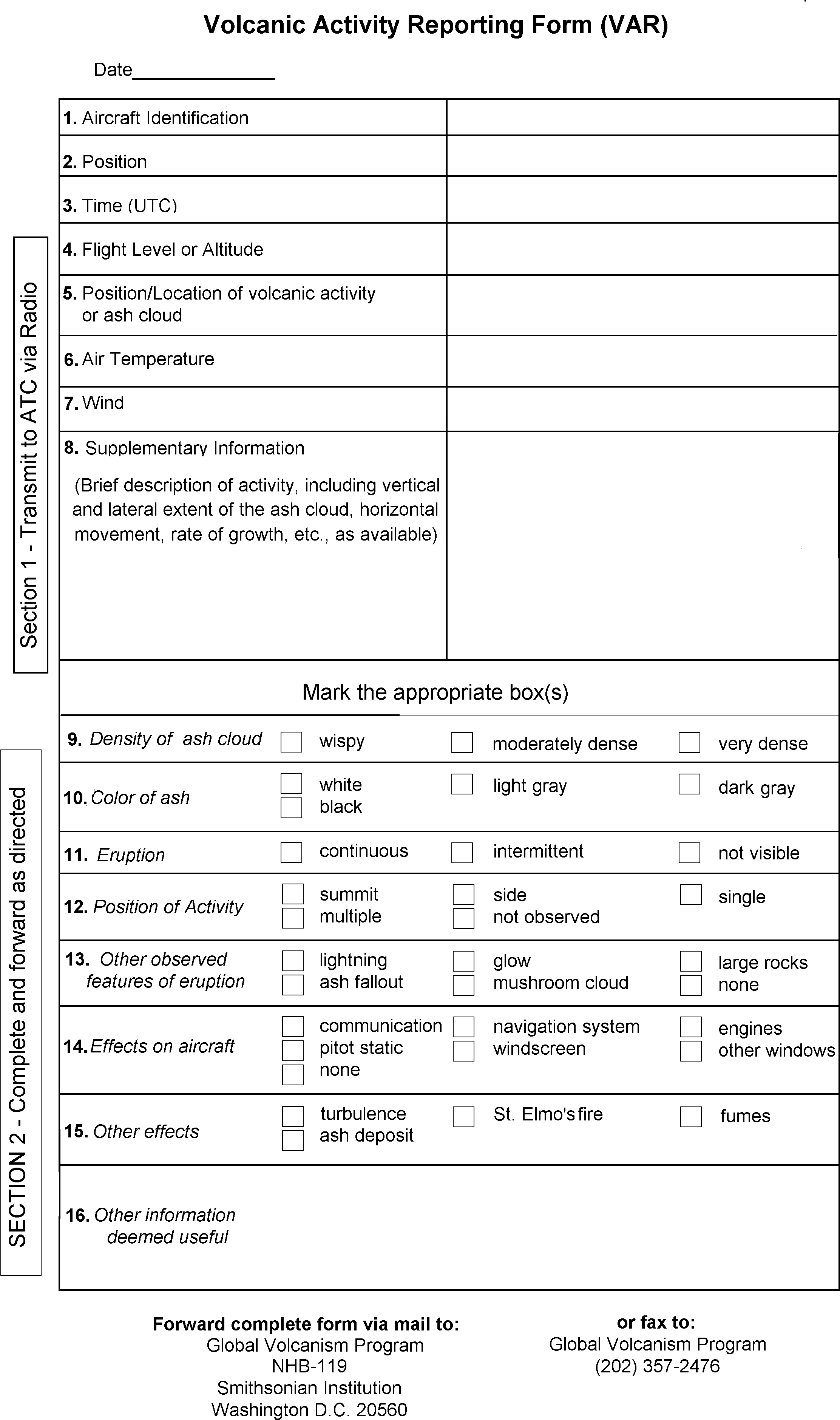Report on Special Announcements (Unknown) — May 1997
Bulletin of the Global Volcanism Network, vol. 22, no. 5 (May 1997)
Managing Editor: Richard Wunderman.
Special Announcements (Unknown) Aviator's observation form
Please cite this report as:
Global Volcanism Program, 1997. Report on Special Announcements (Unknown) (Wunderman, R., ed.). Bulletin of the Global Volcanism Network, 22:5. Smithsonian Institution. https://doi.org/10.5479/si.GVP.BGVN199705-600300
Special Announcements
Unknown
Lat Unknown, Unknown; summit elev. m
All times are local (unless otherwise noted)
Tens of commercial jet aircraft, which are not designed to fly through particulate and corrosive gases, have suffered damage from inadvertently encountering ash clouds that had drifted tens to hundreds of kilometers from erupting volcanoes; in one case, a plane descended more than 6 km before the engines could be restarted (Casadevall, 1994). As a result of this vulnerability, there have been new and evolving strategies for alerting aviators as to the presence, location, and movement of eruption plumes. Conversely, pilots often see aspects of volcanism that merit preservation in the Bulletin. In order to solicit and register these observations, a form for pilots relates a series of key questions (plate 1, back page).
 |
Plate 1. A form developed to help pilots record and submit their observations related to volcanism. Courtesy of Ed Miller, ALPA. |
The form, called the "Volcanic Activity Reporting Form," is now included in the US Aeronautical Information Manual (FAA, 1995), a reference used by all large US carriers. A similar form is in use by members of the International Civil Aviation Organization (ICAO).
The form is divided into two parts. The critical upper part (numbers 1-8) gets radioed to air traffic control immediately. Most of the form's lower part provides stated choices on topics such as ash density and color, continuousness of the eruption, as well as the effects on the aircraft and atmosphere (numbers 9-15). The last block (number 16) allows pilots to provide further written information.
The forms are ultimately to be sent (via mail or fax) to GVN for archiving. Expenses for postage or connections by fax can be reimbursed by the GVN.
In addition to the form itself, we wish to receive other aviation observations. These may include eyewitness accounts or photos made by passengers or crew, descriptions of damage, or ash collected by mechanics, as well as relevant weather details from meteorologists. These can (and already do) complement volcanological and atmospheric studies of eruptive activity. Ideally, such multiple perspectives can build a much more comprehensive picture of volcanic processes than can result from any one vantage point.
Every day thousands of people fly across potentially ash-contaminated airspace--to some degree, the people in these planes are just as vulnerable as villages perched on a volcano's flanks. Conventional planes still lack on- board instruments to warn pilots if hazardous atmospheric ash lies ahead. Such plumes are relatively rare, but to consistently avoid them requires interdisciplinary communication and cooperation between both aviators and scientists.
References. Casadevall, T.J. (ed.), 1994, Volcanic ash and aviation safety, Proceeding of the First International Symposium on Volcanic Ash and Aviation Safety (Seattle, Washington, July 1991): U.S. Geological Survey Bulletin 2047, 450 p.
Federal Aviation Administration, 1995, Volcanic Activity Reporting Form: US Aeronautical Information Manual (AIM), 1995 (June), Appendix 2 (1 May 1997), p. A2-1, Superintendent of Documents, US Government Printing Office, Washington, D.C.
Further Reference. Casadevall, T.J., and Thompson, T.B., 1995, Volcanoes and principal aeronautical features, Geophysical Investigation Map GP-1011: U.S. Geological Survey, prepared in cooperation with Jeppesen Sanderson, Inc.
Geological Summary. Special announcements or information of general interest not linked to any specific volcano.
Information Contacts: Captain Ed Miller (Retired), Air Line Pilots Association, 535 Herndon Parkway, P.O. Box 1169, Herndon, VA 20172-1169 USA; Tom Fox, Air Navigation Bureau, International Civil Aviation Organization (ICAO), 999 University St., Montreal H3C 5H7, Canada.

